Red light therapy supercharges your cellular ATP production in multiple ways. It activates cytochrome c oxidase, enhances electron transport chain efficiency, and stimulates mitochondrial energy output. You'll benefit from improved oxygen consumption, enhanced cellular respiration, and improved metabolic efficiency. The therapy breaks harmful nitric oxide bonds, allowing better electron flow through mitochondrial complexes. Specific wavelengths (630-850 nm) drive ATP synthesis while reducing intracellular water viscosity, and pulsed light exposure maximizes these effects. When combined with ideal timing and power levels, these mechanisms work together to amplify your cellular energy production. The science behind these processes reveals even more fascinating benefits.
Cytochrome C Oxidase Activation
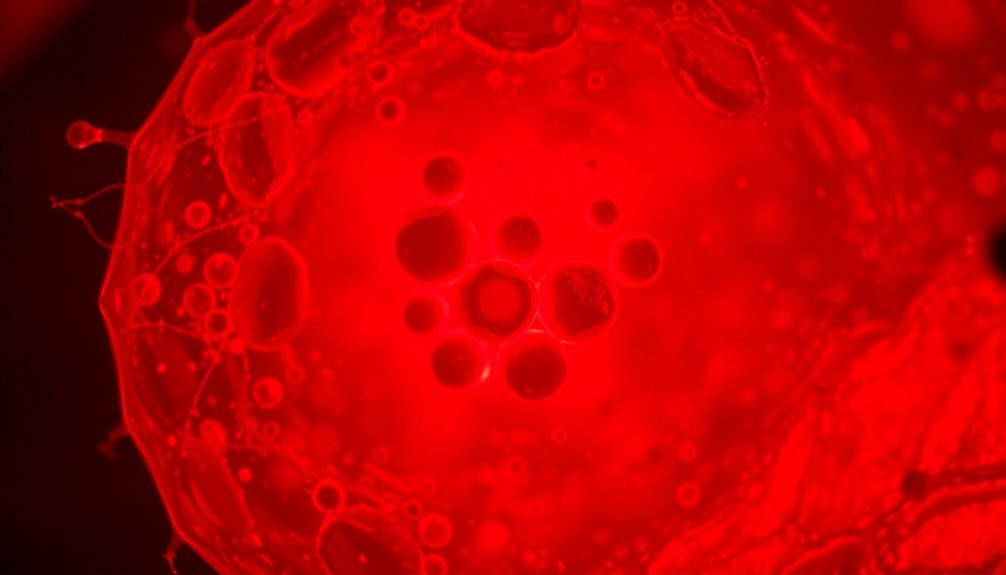
Cytochrome C oxidase's essential role in cellular energy production makes it a prime target for red light therapy. As a vital enzyme in your electron transport chain, it transfers electrons from cytochrome c to oxygen, creating the proton gradient needed for ATP synthesis.
When you expose your cells to red and near-infrared light, you're directly enhancing this enzyme's activity. This enhanced activity leads to boosted ATP production, which is crucial for cellular repair and function.
The activation process is remarkably precise. When specific wavelengths of red light, particularly 850nm and 940nm, hit your cells, they excite electrons within cytochrome C oxidase. This excitement helps break the bonds of nitric oxide, which can inhibit the enzyme's function. By removing this inhibition, you're effectively clearing the path for superior electron transport and ATP production.
You'll find that activated cytochrome C oxidase improves more than just energy production. It helps reduce oxidative stress, supports faster recovery from physical exertion, and enhances your brain function.
Research has consistently shown these benefits, with studies on both cell cultures and animal models demonstrating significant increases in cell respiration and electron transport system capacity when exposed to continuous red light irradiation.
Electron Transport Chain Enhancement
Three key mechanisms make red light therapy a powerful enhancer of your electron transport chain (ETC).
First, photons from red and near-infrared light excite electrons, facilitating their movement through the ETC. This enhanced electron flow directly increases your cells' ATP production as the light energy converts to chemical energy. ATP recycling occurs continuously throughout each day to maintain energy levels.
Second, red light therapy breaks the bond between nitric oxide (NO) and cytochrome C oxidase. Since NO competes with oxygen in your ETC and limits ATP production, its removal markedly improves the chain's efficiency.
You'll benefit from reduced oxidative stress and enhanced mitochondrial function when these NO blockades are cleared.
Third, specific wavelengths (850nm and 940nm) stimulate your mitochondrial complexes, boosting both electron transport capacity and cytochrome C oxidase activity.
This stimulation's effectiveness depends on proper light intensity and duration. You'll want to verify you're getting the right power levels – studies show that 0.8-1.1 W of 908nm light stimulates ATP production, while lower levels around 0.1 W can actually inhibit it.
Brief exposure periods of 30 seconds to 1 minute can be sufficient to enhance your ETC function.
Mitochondrial Energy Production
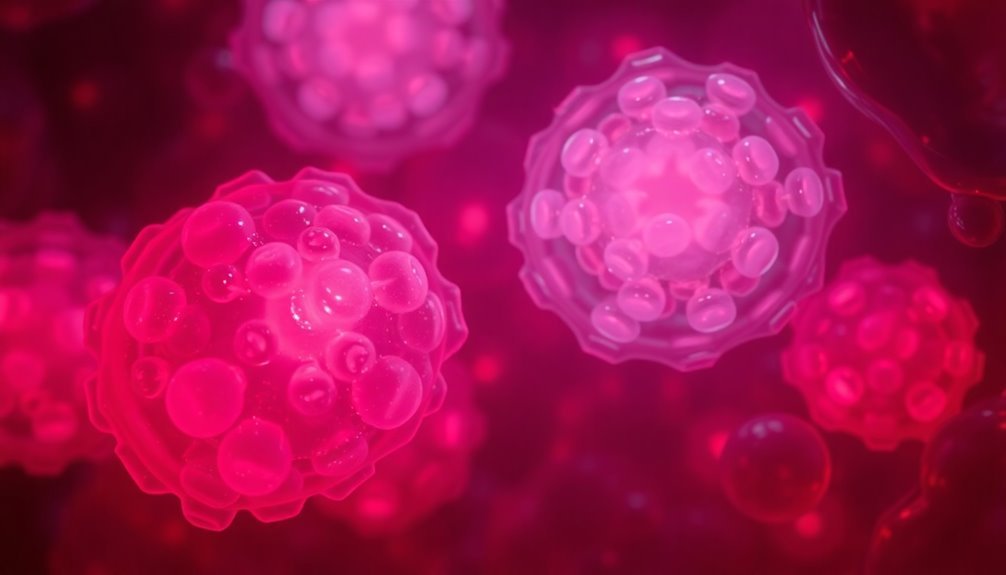
Building on these electron transport chain improvements, red and near-infrared light therapy directly boosts your cellular powerhouses – the mitochondria. When you expose your cells to specific wavelengths, particularly 850nm and 940nm, you're enhancing both the efficiency and number of mitochondria, leading to increased ATP production. This enhancement is vital since humans need to recycle their body weight in ATP molecules each day.
You'll experience improved cellular respiration across all key stages – from glycolysis to oxidative phosphorylation. The light therapy specifically targets cytochrome c oxidase, an essential enzyme in your mitochondrial complexes, optimizing its activity for better energy production. This enhancement means your cells can convert nutrients into ATP more effectively while reducing harmful oxidative stress.
What's especially remarkable is how photobiomodulation at 810nm wavelength can boost your mitochondrial energy output within minutes. The intensity of the light matters greatly – there's a sweet spot that maximizes ATP synthesis without causing inhibitory effects.
Your mitochondria respond to this targeted light therapy by increasing their complex respiration and electron transport system capacity, ultimately leading to more robust cellular energy production and improved overall cellular health.
Nitric Oxide Release
Light therapy's impact on nitric oxide (NO) release plays a significant role in cellular energy production. When NO binds to cytochrome C oxidase in your cells, it competes with oxygen and impairs the electron transport chain's efficiency. This interference reduces ATP production and leads to increased oxidative stress, potentially causing cellular damage.
Red and near-infrared light therapy helps break these NO bonds, which is essential for restoring efficient energy production. When you receive red light therapy, you'll experience several key benefits:
- Enhanced ATP production through improved electron flow in the mitochondria
- Reduced oxidative stress levels as NO dissociates from cytochrome C oxidase
- Increased mitochondrial efficiency and overall cellular function
The release of NO from cytochrome C oxidase directly impacts your cells' energy-producing capacity. As the NO molecules dissociate, oxygen can better interact with the electron transport chain, leading to more efficient ATP production. Optimal results occur when therapy is administered during peak morning hours between 8 and 11 a.m.
This process helps maintain proper cellular energy balance and supports healthier mitochondrial function. The improvement in NO handling through red light therapy ultimately contributes to better cellular performance and increased energy production throughout your body.
Cellular Respiration Optimization
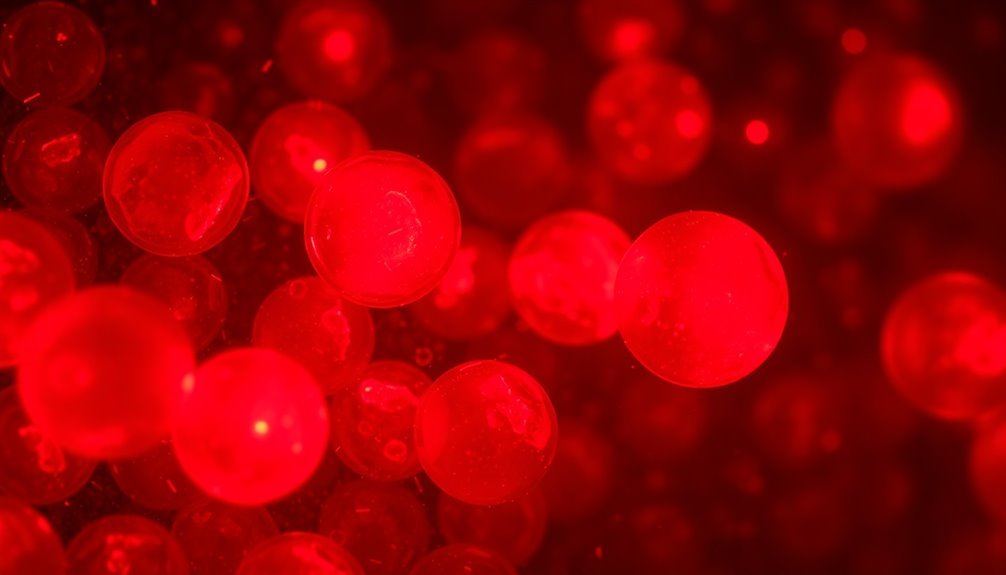
The optimization of cellular respiration takes center stage in red light therapy's ability to boost ATP production. When red light interacts with your cells' cytochrome c oxidase, it enhances the electron transport chain's efficiency, leading to improved ATP generation. This interaction breaks the bond between nitric oxide and the enzyme, allowing for more efficient cellular respiration. Studies show that reduced oxidative stress results from this optimized cellular function.
| Process | Benefit |
|---|---|
| Enhanced Electron Transport | Increased ATP Production |
| Improved Mitochondrial Function | Better Energy Utilization |
| Optimized Cytochrome c Oxidase | Enhanced Cellular Repair |
Your cells' mitochondria become more efficient at converting nutrients into energy when exposed to red light therapy. This optimization means they'll produce more ATP using the same resources, particularly benefiting high-energy-demanding cells like muscles and neurons. You'll experience improved cellular regeneration and repair as your cells have more energy available for essential functions.
The enhanced cellular respiration process helps maintain healthy energy levels throughout your body. With optimized mitochondrial function, you're better equipped to handle oxidative stress while supporting improved athletic performance and cognitive function. This efficient energy production creates a sustainable cycle of cellular health and regeneration.
Antioxidant Defense Stimulation
Your body's antioxidant defense system gets a significant boost from red light therapy, which helps neutralize harmful free radicals and reduce oxidative stress at the cellular level.
You'll experience enhanced protection against cellular damage as red light stimulates your mitochondria to produce more antioxidants while simultaneously improving electron transport efficiency.
The therapy's ability to break up nitric oxide bonds and support overall mitochondrial function strengthens your natural defense mechanisms, creating a more balanced and resilient cellular environment.
Reduces Free Radical Damage
Red light therapy kicks off a fascinating cellular defense mechanism by briefly increasing reactive oxygen species (ROS), which then prompts your body's natural antioxidant responses.
Studies have shown that LED-powered devices are safer and more suitable for daily treatments compared to high-intensity lasers.
When you expose your cells to red light, you'll trigger a protective cascade that helps neutralize harmful free radicals and restore balance to your cellular environment.
Your cells respond to red light therapy by strengthening their antioxidant defenses in several key ways:
- It upregulates your natural antioxidant enzyme activity, helping your cells better combat oxidative stress and prevent damage to proteins, fats, and DNA.
- It enhances mitochondrial function, leading to improved energy production while simultaneously reducing harmful oxidative byproducts.
- It promotes cellular healing and regeneration by maintaining the delicate balance between free radicals and antioxidants.
The intensity of red light therapy matters considerably in managing oxidative stress.
You'll get the best results with low to moderate intensity treatments, as excessive exposure can potentially increase oxidative stress.
When used correctly, red light therapy helps prevent cellular damage and supports your body's natural healing processes, contributing to better long-term health and reduced risk of age-related diseases.
Boosts Natural Defense Systems
While your body naturally produces antioxidant enzymes to combat oxidative stress, red light therapy greatly amplifies this defensive system. When you receive red light treatment, it stimulates your cells to increase their production of key antioxidant enzymes, particularly superoxide dismutase (SOD) and glutathione peroxidase (GPx), which serve as your body's primary defense against harmful free radicals.
The therapy works by interacting with cytochrome c oxidase in your cells, triggering a cascade of protective mechanisms. This interaction doesn't just boost your antioxidant enzyme activity – it also helps maintain your mitochondrial integrity and supports sustained ATP production under stressful conditions.
You'll benefit from enhanced cellular resilience as the red light helps your cells better resist external stressors.
What's particularly significant is how red light therapy creates a dual benefit: it simultaneously reduces reactive oxygen species (ROS) while strengthening your body's natural antioxidant defenses.
This combination provides thorough protection against oxidative damage, helping your cells maintain ideal function and energy production even when under stress. The result is a more robust cellular defense system that better protects your body's tissues and organs.
Light-Driven ATP Synthesis
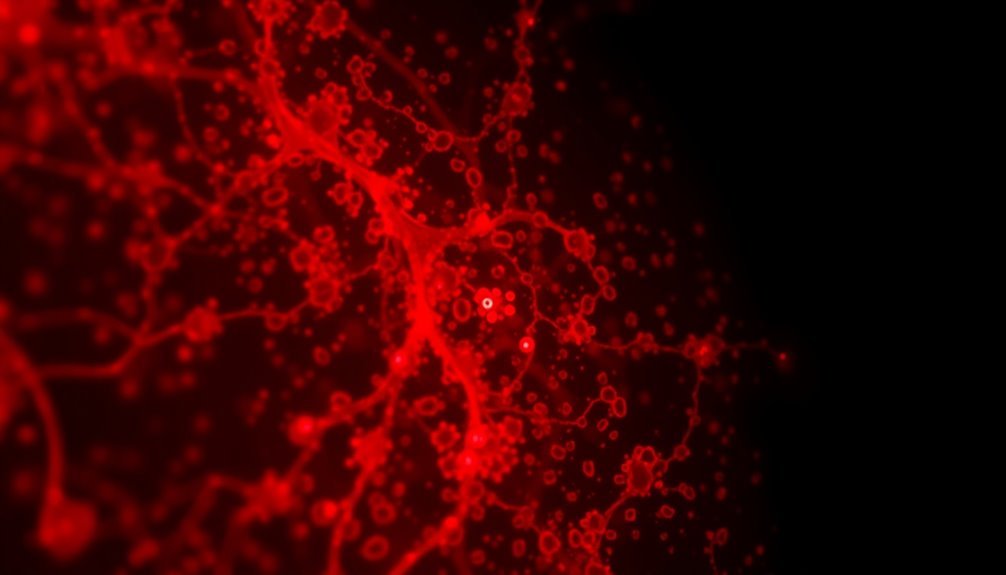
Red light at specific wavelengths between 630-850 nm penetrates your cells to trigger ATP production through specialized energy absorption mechanisms.
Your mitochondria's electron transport chain responds to this light exposure by accelerating the flow of electrons and protons, leading to enhanced ATP synthesis.
You'll experience increased cellular energy production as the light activates key mitochondrial complexes, optimizing their ability to convert light energy into chemical energy through photobiomodulation.
This targeted light therapy helps maintain hundreds to thousands of mitochondria in each cell, ensuring optimal energy generation throughout your body.
Wavelength-Specific Energy Absorption
Light-driven ATP synthesis relies on specific wavelengths that trigger cellular energy production, with ideal ranges falling between 613-846 nm. You'll find that wavelengths between 780-830 nm provide maximal cellular penetration, while 670 nm light reduces intracellular water viscosity to enhance ATP production. The 980 nm wavelength specifically interacts with mitochondrial complexes III and IV when higher power is applied. Clinical evidence demonstrates that these light therapies are effective for pain and wound management.
The effectiveness of these wavelengths depends on several key factors:
- Power levels between 0.3-1.1 W maximize ATP production without causing oxidative stress
- Pulsed red and near-infrared light shows better results than continuous wave exposure, especially in stressed cells
- Frequency settings around 10 Hz outperform higher frequencies like 100 Hz for ATP synthesis
When your cells absorb these specific wavelengths, they trigger a cascade of beneficial effects. The light energy interacts with your cell membranes and mitochondrial cytochromes, enhancing ATP production through photobiomodulation.
This increased ATP supports essential cellular functions, including metabolism, signaling pathways, and tissue repair processes. You'll notice that short exposure periods can greatly boost mitochondrial energy output, though these effects are typically temporary.
Electron Transport Chain Activation
Through intricate biochemical pathways, photons trigger a complex series of reactions in your cells' electron transport chain, leading to enhanced ATP production. When light hits Photosystem II (PSII), it energizes electrons to a higher energy state, initiating a cascade of electron transfers through the transport chain. These excited electrons are replaced by new ones split from water molecules.
As electrons flow through the chain, they lose energy gradually, and this energy powers proton pumps that move H+ ions into the thylakoid interior. This creates a strong proton gradient across the membrane. The concentrated protons then flow down their gradient through ATP synthase, which acts like a molecular turbine to produce ATP – your cells' energy currency. The ATP synthase consists of CF1 and CF0 subcomplexes that work together to facilitate ATP synthesis.
Your cells regulate this process through the thioredoxin system, which activates ATP synthase in the light and deactivates it in the dark. The cytochrome b6f complex fine-tunes electron transport based on light conditions, while the Q cycle helps maximize proton translocation.
This entire process, called chemiosmosis, efficiently converts light energy into chemical energy, providing your cells with the ATP they need for various functions.
Mitochondrial Light Response Mechanisms
Inside your cells' power plants, mitochondria respond dynamically to red and near-infrared light by activating specialized mechanisms that boost ATP production. When light hits your mitochondria, it primarily targets cytochrome c oxidase (CCO), triggering a cascade of events that enhance cellular energy production. This interaction dissociates inhibitory nitric oxide from CCO, allowing for improved electron transport and increased membrane potential. Recent research using engineered proton pumps in C. elegans demonstrated successful conversion of light energy into chemical energy within mitochondria.
The light-driven ATP synthesis process works through several key mechanisms:
- Light activates proton pumps that increase mitochondrial membrane potential, leading to more efficient ATP production and potentially extending cellular lifespan.
- Near-infrared light reduces the viscosity of intramitochondrial water, which helps your ATP synthase motor rotate more efficiently.
- Pulsed light therapy produces stronger biostimulatory effects than continuous waves, especially in stressed cells, by enhancing metabolism and reducing water viscosity.
Your mitochondria's response to light also involves sophisticated redox signaling pathways that regulate ATP production. When combined with specific pulse frequencies, these mechanisms optimize cellular energy generation and help maintain healthy mitochondrial function, making light therapy an effective tool for boosting cellular energy levels.
Metabolic Efficiency Boost
The remarkable boost in metabolic efficiency occurs when red light therapy optimizes cellular energy production through multiple pathways. When you undergo red light therapy, your cells experience enhanced cytochrome c oxidase activity, leading to improved electron transport and ATP synthesis. This optimization directly affects your mitochondria's ability to convert nutrients into usable energy.
The therapy works by reducing oxidative stress while simultaneously improving mitochondrial performance. You'll benefit from increased protection against cellular damage, ensuring your mitochondria maintain peak efficiency. Additionally, certain wavelengths of red and near-infrared light can stimulate direct ATP production within the mitochondria.
| Metabolic Pathway | Effect on ATP Production |
|---|---|
| Electron Transport | Enhances cytochrome c oxidase activity and improves ETC efficiency |
| Mitochondrial Function | Increases oxygen consumption and cellular respiration rates |
| Oxidative Stress | Reduces ROS and protects mitochondrial integrity |
| Direct ATP Synthesis | Enables direct ATP production from specific light wavelengths |
| Cellular Protection | Strengthens cellular resistance to oxidative damage |
Your cells' energy production capabilities improve through these combined mechanisms, resulting in enhanced metabolic efficiency and increased ATP availability for cellular functions.
Oxygen Consumption Regulation
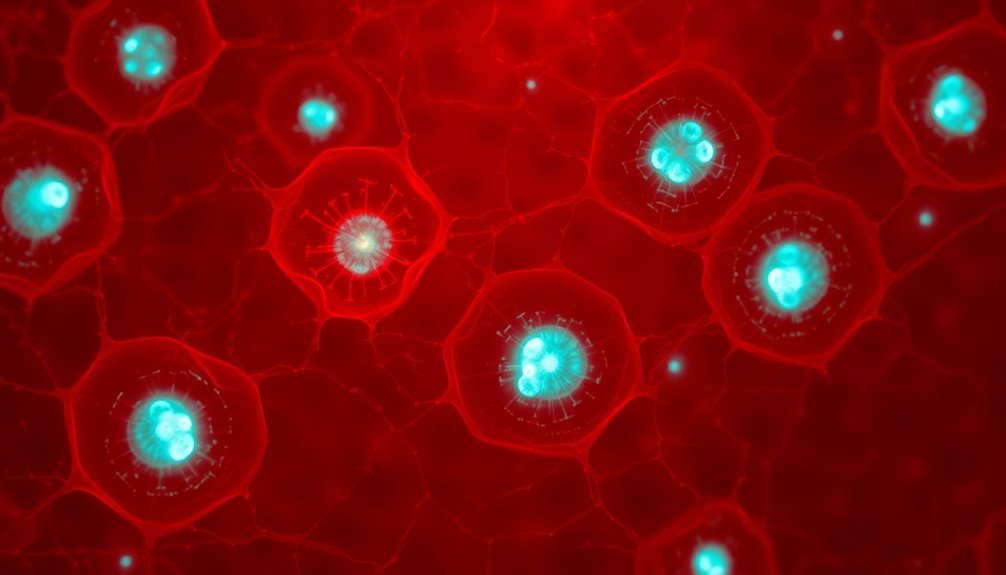
Your cells' oxygen consumption hits peak efficiency when exposed to specific wavelengths of red and near-infrared light, particularly at 850nm and 940nm.
The enhanced activity of cytochrome C oxidase in your mitochondria leads to better oxygen utilization during cellular respiration, while simultaneously reducing oxidative stress through the dissociation of nitric oxide.
This optimized oxygen uptake control allows your mitochondria to produce ATP more efficiently, resulting in improved energy production across your cellular systems.
Peak Oxygen Utilization Patterns
Peak oxygen utilization patterns demonstrate how red light therapy optimizes cellular respiration and ATP production through multiple pathways. When you receive red light therapy, it enhances your cells' ability to utilize oxygen more efficiently, leading to improved ATP synthesis through the electron transport chain (ETC).
The optimization of oxygen consumption in your cells occurs through several key mechanisms:
- Red and NIR light help dissociate nitric oxide from cytochrome C oxidase, reducing oxidative stress and enabling better oxygen utilization.
- Your mitochondria's performance improves, allowing for more efficient oxidative phosphorylation and increased ATP production.
- The therapy stimulates the creation of new mitochondria, expanding your cells' capacity to generate energy.
You'll experience enhanced cellular respiration as red light therapy supports the electron transport process and regulates cellular stress levels. This increased efficiency in oxygen utilization directly impacts your ATP production, leading to improved muscle function and faster recovery.
Research has shown that specific wavelengths, particularly 850nm and 940nm, are most effective at stimulating the electron transport system and optimizing cellular energy production.
Mitochondrial O2 Uptake Control
Building on these oxygen utilization patterns, mitochondrial O2 uptake control represents a sophisticated regulatory system that directly influences your cellular energy production. When red light hits your cells, it activates cytochrome C oxidase, enhancing oxygen consumption and ATP synthesis while dissociating nitric oxide that can interfere with ideal function.
| Control Mechanism | Impact on ATP |
|---|---|
| Electron Transport | Increases efficiency of O2 utilization |
| Proton Gradient | Maximizes energy conversion potential |
| Complex Activation | Enhances ATP synthase performance |
Your mitochondria's oxygen consumption isn't just about quantity – it's about precision control. Red light therapy fine-tunes this process by improving electron transport chain efficiency and regulating the vital proton gradient across mitochondrial membranes. This enhancement leads to better ATP synthase activation and reduced oxidative stress in your cells.
You'll experience increased mitochondrial density and improved dynamics through regular red light exposure, which means more efficient oxygen utilization throughout your cellular network. This maximization doesn't just boost energy production – it also helps protect your mitochondria from damage while supporting essential cellular functions.
Mitochondrial Complex Stimulation
Through a remarkable process, red light therapy directly stimulates the mitochondrial electron transport chain by interacting with cytochrome c oxidase, an essential enzyme complex. This interaction triggers several key mechanisms that enhance your cells' energy production.
When red light hits cytochrome c oxidase, it breaks the bond between nitric oxide and the enzyme, allowing it to resume its crucial role in ATP synthesis.
The stimulation of mitochondrial complexes leads to these critical improvements:
- Your electron transport rate increases considerably, leading to more efficient oxygen consumption and enhanced cellular respiration
- Your mitochondria produce more ATP while using the same amount of resources, making your cellular energy production more efficient
- Your cells experience reduced oxidative stress due to increased antioxidant enzyme activity, protecting mitochondrial function
The wavelengths between 630-850nm are particularly effective at stimulating these mitochondrial complexes, with red light (610-760nm) working on surface tissues while near-infrared light (760-1,400nm) penetrates deeper.
This targeted stimulation of mitochondrial complexes ultimately supports improved cellular function, faster healing, and better overall energy levels in your body's tissues.
Frequently Asked Questions
Does Body Temperature Affect the Effectiveness of Red Light Therapy?
Yes, your body temperature affects red light therapy's effectiveness. You'll get better results when your temperature is between 37-40°C, as warmer tissues absorb light better and enhance mitochondrial activity during treatment.
Can Medications Interfere With Red Light Therapy's ATP Production Benefits?
Yes, certain medications can interfere with red light therapy's ATP benefits. If you're taking nitrates or nitric oxide donors, they may reduce effectiveness by inhibiting cytochrome c oxidase, which is essential for ATP production.
How Soon After Eating Should Red Light Therapy Be Performed?
While there's no specific proven timing for red light therapy after meals, you can safely use it any time. The blood sugar study suggests potential benefits within 15 minutes post-eating, but more research is needed.
Does Skin Pigmentation Influence Red Light Therapy's Cellular Effects?
Your skin pigmentation won't considerably affect red light therapy's cellular benefits. While darker skin may need slightly higher intensity for ideal penetration, the therapy's effectiveness on cellular processes remains consistent across all skin types.
Is There an Optimal Time of Day for Red Light Therapy?
While morning sessions may boost energy and evening sessions support recovery, you'll need to find your ideal time based on your goals and schedule. Research hasn't definitively proven one "best" time.
In Summary
You've discovered how red light therapy can revolutionize your cellular energy production. By understanding these key mechanisms, from cytochrome c oxidase activation to mitochondrial stimulation, you're now equipped to harness red light's power for enhanced ATP synthesis. Whether you're seeking better athletic performance, faster healing, or overall wellness, you'll find that targeted red light exposure can optimize your body's natural energy-producing capabilities.

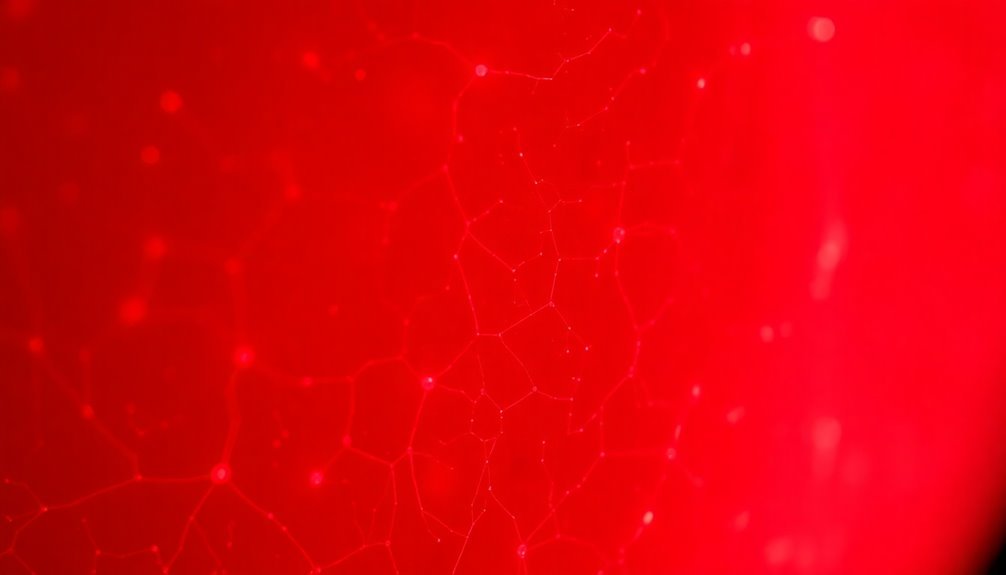



Leave a Reply